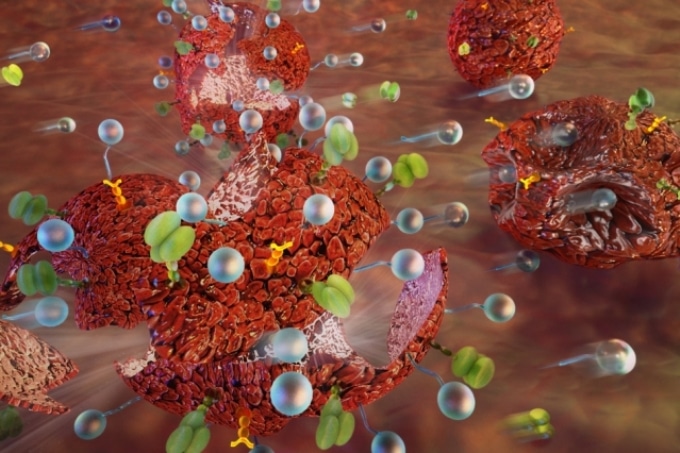



The creative minds at MIT have just devised a new strategy to target and abolish cancerous tumors. Researchers have devised a way to make cancer cells more susceptible to certain types of cancer treatment, by coating the cells with nanoparticles before delivering drugs. By tethering hundreds of tiny particles to the surfaces of tumor cells, the researchers made the cells much more vulnerable to attack by a drug called TRAIL that triggers cancer cells to commit suicide.

The tethered nanoparticles increase the stress exerted on the cells from forces such as flowing blood, making the cells more likely to die. The researchers found that clustering hundreds of tiny particles onto the surfaces of tumor cells made them much more vulnerable to attack by the apoptosis-inducing molecule tumor necrosis factor-related apoptosis-inducing ligand (TRAIL). In mice, the researchers found that the tethered nanoparticles made TRAIL 50% more effective, and this combination eliminated up to 90% of tumor cells.
“When you attach many particles to the membranes of these cells and then expose them to forces that mimic those in the human body, like blood flow, these therapeutics become more effective,” explained lead study investigator Michael Mitchell, Ph.D., a postdoc at MIT’s Koch Institute for Integrative Cancer Research. “It’s a way of amplifying the forces on the cells using polymeric materials.”
In addition to studying tumor cells abnormal genetic and biochemical traits, scientists in recent years have examined how the physical characteristics of these cancer cells contribute to disease progression. Solid tumors exploit physical forces, such as their increased stiffness and altered blood flow, to enhance their survival and growth. Researchers hypothesize that forces exerted by flowing blood and fluid in soft tissues also affects the behavior of cancer and a variety of host cells.
In the current study, the MIT team set out to determine whether physical forces such as those exerted by blood flow might influence how tumors respond to drug treatment. They focused their attention on TRAIL, which is a protein expressed on different cells of the immune system. TRAIL is a member of a family of tumor necrosis factors that bind to death receptors on cell membranes, sending them a signal that stimulates apoptosis, or programmed cell death.
The researchers’ preliminary experiments revealed that tumor cells became more susceptible to this drug after being exposed to shear forces from physiological fluids. “Under these flow conditions, more tumor cells began to die in the presence of the therapeutic molecule,” Dr. Mitchell noted.
Those initial results led the MIT team to propose that they could make cells even more susceptible to the treatment by increasing the forces acting on them. One way to do that is to attach tiny particles to the cell surfaces. Acting like balls on a string, the tethered particles batter and tug at the tumor cell surface as blood flows by, making the cells more susceptible to the cell death signal from the drug.
The particles, which can be injected into the bloodstream, were made of biodegradable polymers known as poly(lactic-co-glycolic acid), or PLGA. Additionally, the particles were coated with another polymer, polyethylene glycol (PEG), that is tagged with a ligand or an antibody specific to proteins found on tumor cell surfaces, which allows them to be tethered to the surface. The researchers tested particles ranging from 100 nm to 1 μm and found that the largest ones were more effective. Also, intuitively, as greater numbers of particles were tethered to the surface, more cells died. However, the investigators noted the effect of the treatment appears to be specific to tumor cells and does not induce apoptosis in healthy cells.
“When you expose cells to forces, and then these particles are coming down on the cell, they could be flattening all these molecules on the surface,” Dr. Mitchell remarked. “Then the receptor can come in better contact with TRAIL to induce tumor cell death.”
The MIT team is now exploring the possibility of using this approach in combination with other drugs that stimulate an immune response, such as drugs that induce a “cytokine storm”—a large release of signaling chemicals that attracts many immune cells to the site to destroy the tumor.
“We’re very interested in combined approaches where you can hit tumor cells with many immune-based therapies and then exploit physical forces that these cells are exposed to, as a new way to kill them,” Dr. Mitchell concluded.
 Relevant
news
Relevant
news